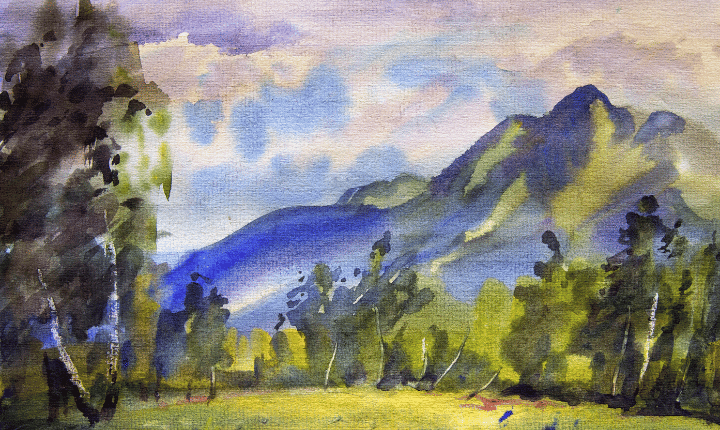Drawing landscapes can be an enjoyable and rewarding experience, but it can also be intimidating for beginners. Knowing where to start, what techniques to use, and how to capture the beauty of nature on paper can seem daunting. That’s why we’ve put together a step-by-step guide for beginners to help you master the art of landscape drawing. Whether you’re an aspiring artist or just looking for a new hobby, this guide will give you the tools and techniques you need to create stunning landscape drawings.
Materials Needed For Landscape Drawing
To start with landscape drawing, it’s important to have the right materials. These include a set of drawing pencils with varying degrees of hardness, ranging from 2H to 6B, allowing you to create a range of lines and shades in your drawing. A good quality sketchbook with acid-free paper is also a must-have for landscape drawing, as it allows you to practice and experiment with different techniques. Other useful materials include:
- An eraser.
- A sharpener.
- A ruler or straight edge.
- A blending tool such as a blending stump or tortillon.
With these materials in hand, you’ll be well-equipped to begin your journey into landscape drawing.
Understanding Composition In Landscape Drawing
Composition is a key element in landscape drawing, as it determines the overall layout and visual appeal of your drawing. When composing your landscape drawing, consider the rule of thirds. This rule involves dividing your drawing into thirds, both horizontally and vertically, and placing your focal point at one of the intersections.
This creates a balanced and visually appealing composition. Another important aspect to consider is the use of foreground, middle ground, and background. This technique creates depth in your drawing, with the foreground being the closest to the viewer and the background being the furthest away. Lastly, consider using lines and shapes in your composition to guide the viewer’s eye and create movement in the drawing. With a solid understanding of composition, you can create beautiful landscape drawings that draw the viewer’s attention and showcase the beauty of nature.

Sketching The Basic Shapes And Forms
Sketching the basic shapes and forms is an essential step in landscape drawing. It helps to establish the overall layout and composition of the drawing and creates a foundation for adding details and textures later on. To start, observe the landscape you wish to draw and identify the basic shapes and forms that make it up, such as hills, trees, and bodies of water.
Then, using light lines, sketch these shapes and forms onto your paper, keeping in mind the composition you’ve established. Don’t worry about adding too much detail at this stage, as the focus is on capturing the overall structure of the landscape. Once you have the basic shapes and forms, you can add more detail and texture to bring the drawing to life. By starting with a solid foundation of basic shapes and forms, you can create a landscape drawing that is accurate and visually appealing.
Adding Detail And Texture To Your Drawing
After sketching the basic shapes and forms of your landscape, it’s time to add detail and texture to bring your drawing to life. This is where you can add depth and dimensionality to your drawing by adding shading, texture, and finer details. One effective technique is hatching and cross-hatching, which involves creating a series of parallel lines or intersecting lines to create shading and texture. technique is stippling, which involves creating a series of dots to create shading and texture.
Adding highlights and shadows to your drawing can also create a sense of depth and dimensionality. Finally, remember to add finer details, such as the texture of leaves or rocks, to bring the drawing to life. By using a combination of these techniques, you can create a landscape drawing that is rich in detail and texture.
Creating Depth And Perspective In Your Landscape Drawing
Creating depth and perspective is essential in landscape drawing, as it helps create a sense of distance and three-dimensionality. One way to create depth and perspective is to use overlapping shapes and forms. This technique involves drawing objects in front of and behind each other to create a sense of depth and distance. Another technique is to use size and scale to create perspective. Objects that are closer to the viewer should be larger and more detailed, while objects that are further away should be smaller and less detailed. The use of atmospheric perspective is also effective in creating depth and distance.
This involves using lighter and cooler colors for objects in the background and darker and warmer colors for objects in the foreground. By combining these techniques, you can create a landscape drawing that is rich in depth and perspective, truly capturing the beauty of the natural world.
Using Light And Shadow To Bring Your Drawing To Life
Using light and shadow is a powerful technique in landscape drawing, as it helps to create a sense of depth, volume, and three-dimensionality in your drawing. One way to use light and shadow is to observe the natural lighting of the landscape you are drawing and use this to create realistic shading and shadowing. For example, if the sun is shining from the left, objects on the right side of your drawing should be shaded and in shadow, while objects on the left should be lighter and more illuminated.
The technique is to use contrast, which involves creating strong contrasts between light and dark areas in your drawing to create a sense of drama and depth. Additionally, you can use a range of shading techniques, such as hatching and cross-hatching, to create texture and volume in your drawing. By using a combination of these techniques, you can bring your landscape drawing to life and create a drawing that is both realistic and visually captivating.
Tips And Tricks For Improving Your Landscape Drawings
Several tips and tricks can help improve your landscape drawings
- Consider using references, such as photographs or sketches of the landscape you wish to draw, as these can help ensure accuracy and detail.
- Experiment with different materials and techniques to create a range of textures and effects, such as using watercolors for a softer, more fluid effect or using graphite for a more realistic, detailed drawing. It’s also important to practice regularly, as this will help to develop your skills and techniques over time.
- Consider joining a drawing group or taking a class to receive feedback and learn new techniques from other artists.
Be bold and make mistakes, which can often lead to discoveries and techniques. By incorporating these tips and tricks into your drawing practice, you can improve your landscape drawings and create artwork that truly captures the beauty of the natural world.
Common Mistakes To Avoid In Landscape Drawing
While landscape drawing can be a rewarding and fulfilling hobby, there are some common mistakes that artists should aim to avoid. One of the most common mistakes is failing to establish a clear composition, resulting in a cluttered or confusing drawing. It’s important to plan out the composition of your landscape drawing and to sketch out the basic shapes and forms before adding detail and texture. Another mistake is using unrealistic colors or failing to observe the natural lighting of the landscape, which can result in a flat or unconvincing drawing. Instead, pay attention to the natural colors and lighting of the landscape, and use these to guide your color choices and shading.
It’s important to keep the drawing manageable, which can lead to a loss of spontaneity and freshness. Take breaks and step back from your drawing periodically to assess your progress and to avoid becoming too absorbed in details. Finally, avoid being too self-critical or comparing your work to others, as this can stifle creativity and enjoyment. Instead, embrace mistakes and use them as opportunities to learn and grow as an artist. By avoiding these common mistakes and staying focused on the process of creating, you can create landscape drawings that are accurate and visually appealing.
Inspiration And Resources For Landscape Drawing
Many sources of inspiration and resources are available for artists interested in landscape drawing. One of the most accessible sources of inspiration is the natural world itself. Explore local parks, forests, and the countryside to find inspiration for your drawings. Also, many art books and online resources provide tips, techniques, and inspiration for landscape drawing. Websites like Pinterest and Instagram can be useful for finding reference photos and connecting with other artists. Art classes and workshops can also be a great source of inspiration and learning, as they provide opportunities to learn new techniques and receive feedback from other artists.
Consider joining a local art group or club where you can connect with other artists, participate in group exhibitions, and receive support and encouragement in your artistic journey. By exploring a range of inspiration and resources, you can continue to grow as an artist and develop your skills and techniques in landscape drawing.
Putting It All Together: Drawing Your Landscape Masterpiece
Drawing your landscape masterpiece can seem daunting, but following a few key steps makes it possible to create a beautiful and compelling drawing. Begin by selecting a landscape that inspires you and sketch the basic shapes and forms.
Then, add detail and texture to your drawing, paying attention to using light and shadow to create depth and dimension. Next, consider the composition of your drawing, ensuring that it is well-balanced and visually appealing. Next, experiment with a range of materials and techniques to create a variety of textures and effects, and be sure to practice regularly to refine your skills. As you work on your drawing, take breaks and step back periodically to assess your progress and make adjustments as needed. Finally, feel free to make mistakes or to try new techniques, as this can lead to unexpected and exciting results. With time, practice, and dedication, you can create a landscape masterpiece that is both a reflection of your creativity and a homage to the natural world.
Conclusion
Landscape drawing is a rewarding and fulfilling art form that allows artists to capture the beauty and majesty of the natural world. By understanding the principles of composition, form, texture, and lighting, artists can create stunning and evocative landscape drawings that inspire and delight viewers. While there are common mistakes to avoid, such as overworking a drawing or using unrealistic colors, many sources of inspiration and resources are available to artists, including exploring the natural world, joining art groups, and taking classes or workshops. With practice, dedication, and a willingness to experiment and learn, anyone can create a landscape masterpiece that reflects their unique perspective and artistic vision.


Commented Posts